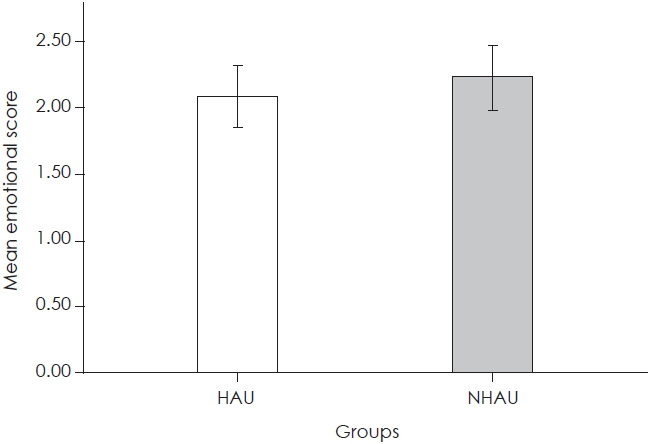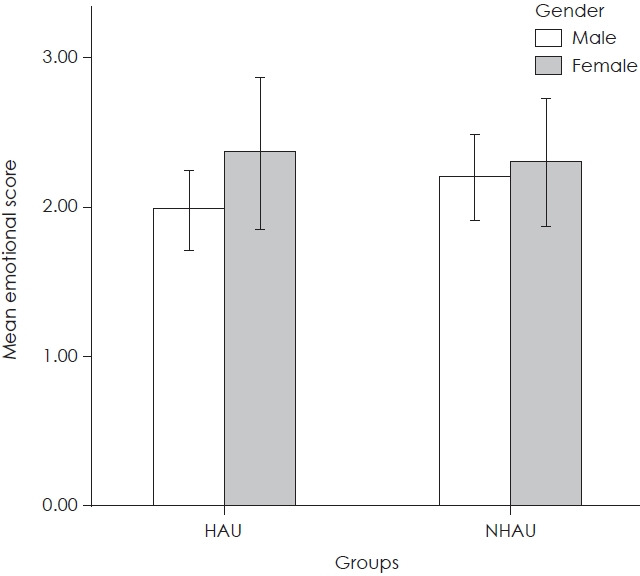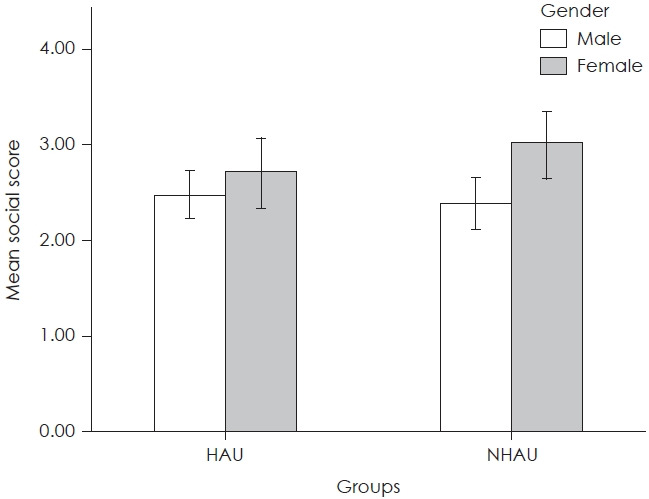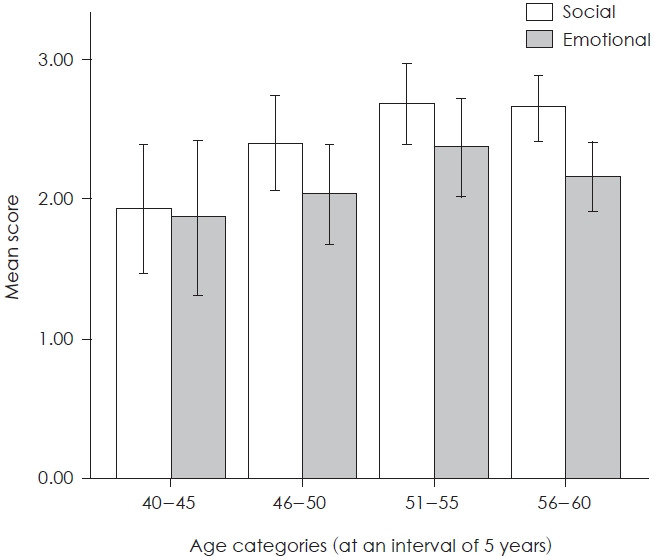Abstract
Background and Objectives
Severe to profound hearing loss impacts the capacity for verbal communication as well as the social, emotional, and overall quality of life; however, the association between socio-emotional rehabilitation and post-hearing aid use is not widely explored. This study aimed to investigate the socio-emotional change in post-hearing aid fitted individuals with severe to profound hearing loss.
Materials and Methods
A total of 60 individuals comprised of 15 females and 45 males with severe to profound hearing loss within the age range of 40-60 years (mean age and standard deviation of 53.4±6.1), participated in this study. Participants were divided into two categories with a 10-year age interval i.e., 40–50 and 51-60 years. These participants were equally divided into hearing aid user (HAU) and non-hearing aid user (NHAU) groups. The hearing handicapped inventory for the adults-short version (HHIA-S) adapted from Weinstein & Ventry (1983) was used in this study.
Results
The mean social score of all the participants was significantly higher than the mean emotional score. However, no such advantage was observed between the HAU and NHAU groups. The mean social score of females in the HAU category was significantly higher than males. The mean social and emotional scores were also compared across two age categories in the age range of 40-50 and 51-60 years and revealed no significant difference between mean social and emotional score across the age categories (p=0.026).
Conclusions
In individuals with severe to profound hearing loss, social rehabilitation occurs quicker than emotional. In the HAU group, socialization occurred faster in females than males. These findings suggest that a customized counselling should be developed for the social and emotional wellbeing as these two parameters improve distinctly.
Keywords: Emotional skills, Hearing aids, Hearing loss, Mental health, Social skills
Introduction
Hearing loss is one of the major constituents of disability, yet impact of hearing loss on mental health is not widely explored [1]. Hearing loss ranges from mild (10% to 25%) to profound (upto 100%) category of disability. Apart from difficulty of interpreting day to day conversation these individuals also face remarkable amount of socio-emotional challenges. These challenges impact mental health and quality of life (QOL). Changes in personality and social isolation are often observed in those individuals with hearing loss who are not aurally rehabilitated. Increased amount of stress can lead to the fear of losing relationship or social standing can have huge emotional impact. These stressful situations can impact mental health as well as general health of an individuals.
There are plenty of literature highlighting varying impact of hearing impairment on mental health as well as QOL in western population. After the fitting of hearing aid in elderly adult (age range 60-90 years) in Brazilian population QOL improved significantly in mainly leisure activities but no significant changes in the frequency of negative feelings [2]. The impact of hearing loss on health, QOL and well-being depend on age and onset of hearing loss such as social isolation and loneliness is differ in older adults (age more than 65 years) than younger adults [3], younger adults has more risk for depression [4]. Buffering effect of hearing aid use on perceived social and emotional loneliness in US population in the age range 62-92 years and they found a significant change in feeling of loneliness after 4-6 weeks of hearing aid use in individuals who had moderate to severe hearing loss [5]. The impact of hearing aid fittings among elderly patients in northern region of Brazil over aged of 65 years through Hearing Handicap Inventory for Elderly questionnaire, they found that use of hearing aid significantly improves the hearing handicap, but some older adults still maintain social and emotional limitations [6]. So aural rehabilitation by amplification devices are effective in terms of improvements in social isolation, depression and cognitive tasks among older adults with different degree of hearing loss [7].
Existing literature suggests that impact of hearing impairment especially severe to profound degree can trigger varying level of socio-emotional anxiety among hearing aid users (HAUs). Besides, the socio-personal configuration within Indian community is highly varying compared to the western population [8]. The attitude and acceptance of hearing disability are also society specific [9]. The stress coping strategy are also widely varying across different communities. Based on these observations the need for investigation of socio-emotional perspective in individuals with severe to profound hearing loss, who use hearing aid was identified.
The primary objective of this research was to check whether the mean emotional score (rating) and mean social score (rating) were different for person with HAU when compared with non-hearing aid user (NHAU). Furthermore, it was also aimed to check whether scores were different across age and sex. In this study the participants were individuals with hearing loss in the age range of 40-60 years. These individuals were categorized intwocategories i.e., 40-50 years, 51-60 years. It was also aimed to investigate whether age of onset of hearing loss the age range of 40-60 years has any impact on overall QOL.
Materials and Methods
Participants
A total of 60 individuals (15 females and 45 males) with severe to profound hearing loss in the age range of 40-60 years (mean age of 53.4±6.1) participated in this study. Out of which 30 individuals (7 females and 23 males) with mean age 53.5±6.7 were using hearing aids (HAU) and another 30 individuals (8 females and 24 males) with mean age 53.3±5.4 years were not using any mode of amplification (NHAU). Twenty five out of 30 HAUs were using behind the ear and five were using receiver in the canal hearing aids. Twenty-four bilateral (B/L) and six unilateral (U/L) HAUs participated in this study (Table 1).
Table 1.
Descriptive analysis of age range, mean years of onset of hearing loss, hearing aid types such as BTE, and RIC, laterality of hearing aid fitting such as bilateral (B/L), unilateral (U/L), mean years of hearing aid uses and aided ear of the participants
| Age range (yr) | No. of participants | Mean years of hearing Loss | Hearing aid type | Mean months of hearing aid uses | Aided ears |
|---|---|---|---|---|---|
| 40-45 | 3 | 2.2±0.72 | RIC (3) | 8.3±1.52 | U/L (2) |
| B/L (1) | |||||
| 46-50 | 6 | 4.6±0.96 | RIC (1), BTE (5) | 12.6±3.72 | U/L (1) |
| B/L (5) | |||||
| 51-55 | 11 | 4.6±0.78 | RIC (1), BTE (10) | 13.5±5.64 | U/L (3) |
| B/L (8) | |||||
| 56-60 | 10 | 6.0±1.41 | BTE (10) | 15.1±6.64 | B/L (10) |
BTE, behind the ear; RIC, receiver in the canal
All participants were examined by an audiologist. Pure tone audiometry, speech reception threshold, and speech detection threshold tests were performed. Individual having sensorineural and mixed hearing loss with severe to profound deafness (41-90 db); hearing amplification using digital hearing aid with at least 6 months of hearing aid usage were included. Any individual with any comorbid conditions such as auditory processing disorders, neurodegenerative disorders, psychological problems such as stress or anxiety or any other critical medical conditions were excluded.
Test material
Hearing handicapped inventory for the adults-short version (HHIA-S) adapted from Weinstein & Ventry [10] was used in this study. This test was used for the assessment of emotional and social adjustment in adults having hearing loss. A total of 10 questions were asked to both groups (persons with and without HAUs) out of which 5 questions consist of emotional and other 5 under social domains. In HHIA-S questionnaire, question number 1, 2, 4, 7, and 9 assessed the emotional and 3, 5, 6, 8, and 9 targeted the social domain. Three-point rating scale was used with a response ‘yes’ awarded 4 points, ‘sometimes’ 2 points and ‘none’ for 0 points. The score of 0-8 suggested “no hearing handicap,” 10-24 as “mild-moderate hearing handicap” and 26-40 as “significant hearing handicap.”
Procedure
Individuals with severe to profound sensorineural hearing loss were randomly selected from Gurgaon hearing aid center and Best hearing solutions, two leading hearing clinics situated in Gurgaon/Delhi region of India. Demographic information was collected from all participants. Initially Case history and otoscopy were performed on all individuals participated in this study. Individuals with any middle ear pathology and fluctuating hearing loss were excluded. Pure tone audiometry was performed at (250, 500, 1000, 2,000, 4,000, and 8,000 Hz) frequencies and speech audiometry (speech recognition threshold and speech detection threshold) were done through Arphi Proton DX3 Digital audiometer with TDH 39 headphone (Arphi Electronics Pvt Ltd, Mumbai, India). Pure tone average was calculated at 500, 1,000, 2,000, and 4,000 Hz frequencies. All the participants were capable of responding to the questionnaire using verbal mode. Written consent was taken from all participants before administration of the questionnaire (Approval No. JPR/2017/NS/1001). The questionnaire was administered by the qualified audiologist.
Statistical analysis
Obtained data across varies dependent parameter such as mean emotional score and mean social score were conducted. Sapiro-wilk test reveal that above listed two parameter were normally distributed (p<0.05). Independent sample t-test was done to check the level significance across two independent groups such as HAU and NHAU. Level of significance value was tested at p<0.05. Hypothesis was assumed in two tailed direction. Normality test of the mean emotional score of those individuals with severe to profound hearing loss using hearing aid (2.08±1.46) and individual not using hearing aid (2.26± 1.49) were compared across each other. The mean emotional score was computed by adding the response of question no. 1, 2, 4, 7, and 8 (Hearing Handicapped Inventory for Eldersshort verson, HHIE-S).The score was computed by adding the response of question from (HHIA-S). Level of significance was tested at (p<0.05) and assuming the two tailed hypothesis. T-test statistical analysis was performed to check wheather these two groups differed significantly. After observing no significant difference in the mean emotional score across group wise that is HAU and NHAU, it was also compared across gender within the groups. In other words, whether the mean emotional score differed across the males and females within the HAU and NHAU groups. T-test was performed at (p<0.05) level of significance to check whether the mean emotional score of gender differed significantly within the groups.
Results
Mean emotional score of those individuals with severe to profound hearing loss using hearing aid (2.08±1.46) and individual not using hearing aid (2.26±1.49) were compared across each other. The mean emotional score was computed by adding the response of question no. 1, 2, 4, 7, and 8 (HHIES).The score was computed by adding the response of question from (HHIA-S). Level of significance was tested at (p< 0.05) and assuming the two tailed hypothesis. T-test statistical analysis was performed to check wheather these two groups differed significantly. The result revealed that mean emotional score of HAU (2.26±1.49) was not significantly different than the mean emotional score of NHAU (2.08±1.46), (t[1,148]=-0.86, p=0.39) (Fig. 1).
Fig. 1.

Mean emotional score across the group. HAU, hearing aid user; NHAU, non-hearing aid user.
After observing no significant difference in the mean emotional score across group wise that is HAU and NHAU, it was also compared across gender within the groups. In other words, whether the mean emotional score differed across the males and females within the HAU and NHAU groups. T-test was performed at (p<0.05) level of significance to check whether the mean emotional score of gender differed significantly within the groups. For the HAU (t[1,148]=-0.86, p=0.39) group, the result revealed that mean emotional score of females using hearing aids (2.11±1.36) was significantly better than the mean score of male using hearing aids (2.08±1.40). Subsequently, in the NHAU (t[1,298]=-1.36, p=0.39) group, no statistical significant difference in mean emotional score across gender was observed. The mean emotional score of males (2.08±1.49) was significantly not different than females (2.09±1.40) who were not using hearing aid despite severe to profound hearing loss (t[1,148]=-.158, p=0.87) (Fig. 2).
Fig. 2.

Mean emotional score across groups and gender. HAU, hearing aid user; NHAU, non-hearing aid user.
Mean social score of individuals with severe to profound hearing loss was compared across HAU (2.53±1.32) and NHAU (2.54±1.38) groups. The mean social score was computed by adding the response of question no. 3, 5, 6, 9 and 10 (HHIA-S). Level of significance was tested at (p<0.05) and assuming the two tailed hypotheses. The t-test statistical analysis was performed to check whether these two groups differed significantly. The result revealed that mean social score of HAU (2.53±1.32) was not significantly different than the mean score of NHAU (2.54±1.38) (t[1,148]=-2.45, p=0.15) (Fig. 3).
Fig. 3.

Mean social score across the groups. HAU, hearing aid user; NHAU, non-hearing aid user.
After observing no significant difference in the mean social score across group wise that is HAU and NHAU, it was also compared across gender within the groups. In other words, whether the mean social score differed across the males and females within the HAU (2.53±1.32) and NHAU (2.54±1.38) groups. T-test was performed at (p<0.05) level of significance to check whether the mean social score of gender differed significantly within the groups. For the HAU (t[1,148]=-0.92, p=0.35) group, the result revealed that mean social score of females with HAU (2.70±1.15) was significantly better than the mean score of male with HAU (2.40±1.37). Subsequently, in the NHAU (t[1,148]=-2.45, p=0.35) group, statistical significant difference in mean social score across gender was observed. The mean social score of females (3.00±1.11) was significantly different than males (2.38±1.45) who were not using hearing aid despite severe to profound hearing loss (Fig. 4).
Fig. 4.

Mean social score across the gender and groups. HAU, hearing aid user; NHAU, non-hearing aid user.
The result revealed that social and emotional mean score across the age categories (p=0.026) were no significantly different. Within group analysis was done at an interval of 10 years i.e., 40-50 and 51-60 years. One-way anova analysis revealed that no significant difference across social (f[1,58]=0.16, p=0.69) and emotional (f[1,58]=3.2, p=0.08) score was observed (Fig. 5).
Fig. 5.

Mean social and emotional score across two age categories.
Discussion
In the present study socio-emotional aspects of QOL was investigated among individuals with severe to profound hearing loss which were equally categorize into two groups, one using hearing aid and other not using hearing aid. Based on the obtained data analysis it was found that mean emotional score and mean social score were not significantly different across the two groups. However, the mean social score of females in person using hearing aid category was significantly better than males. Furthermore, the mean emotional score of females were higher than the males in the HAU category. The mean emotional and social score were also investigated across the two age categories of the individuals ranging from 40 to 60 years which consisted of 40-50 and 51-60 years. The mean social score of the overall participants (HAU and NHAU group) was no significantly higher than the mean emotional score. However, no such advantage was observed between the HAU and NHAU group.
As evident in this study, the rationale behind non-significant impact of hearing aid uses on social and emotional domain on the participants with HAU could be several. The aural rehabilitation with hearing aid addresses the functional hearing impairment of the person with not significantly improving the socio personal perspective of the individuals. The experience of hearing impairment and its socio personal impact could be varying depending on the time of uses of hearing aid [11]. Based on these reason variable amount of socio-emotional satisfaction could be achieved among HAU [7]. In this study, those participants were included who were rehabilitated with hearing aid within 6 months. Less than six months of hearing aids usage may not be sufficient to establish the socio-emotional domains which get severely shaken by the impact of severe to profound hearing loss.
Hearing loss if persists for longer duration in the elderly population, often results in withdrawal from a variety of social activities. Such isolation behavior may affect socio-personal aspect of life as well as QOL. Reduced auditory and intellectual stimulation may give rise to changes in the central nervous system and it may affect the development of cognitive decline and dementia [11]. Literature review on hearing loss or poor speech recognition score has been found associated with overall wellbeing [12]. Significant decline in feeling of loneliness and isolation has been reported within 4 to 6 weeks of hearing aid uses in older person with moderate to severe hearing loss [1,13]. Thus, prolonged unaided hearing threshold can induce gradual reduction in overall QOL [14].
The findings of this study advocate the need for investigation of social and emotional wellbeing in persons with severe to profound hearing loss who are using hearing aid. The impact of severe to profound hearing loss can induce differential level of mental health challenges. Similarly, socio emotional stress caused by hearing disability can induce varying level of challenges across the increasing the age range [15,16]. Furthermore, family support, individual stress coping strategies socio-personal-professional engagement and previous experience also could be the confounding variables in manifestation of stress related symptoms [17]. Thus, a comprehensive rehabilitation program is advocated for individuals with severe to profound hearing loss which should include audiological intervention along with socio-emotional augmentation [18].
Further research shall focus on the impact of socio-emotional health in those individuals who’s hearing aid usage duration is over 6 months onwards. As in literature, long-term effect of hearing aid uses on mental health is not comprehensively documented. Secondly, socio-emotional health of individuals with mild to moderate hearing loss shall be investigated, as in this study only severe to profound hearing loss individuals were included.
In conclusion, main objective of this research was to check whether the mean emotional and social score were different for person with HAU when compared with NHAU. Results showed that mean social score was higher than emotional score across the age categories in both HAU and NHAU groups but when compared across the gender females emotional and social score was better than males in HAU group only social score was better in females than males in NHAU group. It was evident that the recovery pattern of social and emotional component occurs distinctly. These findings can assist in client specific counselling shall be developed for socio-emotional adjustment in case of acquired hearing loss occurs distinctly.
Acknowledgments
Sincere thanks to all the participants of this study.
Footnotes
Conflicts of Interest
The authors have no financial conf licts of interest.
Author Contributions
Conceptualization: all authors. Data curation: all authors. Formal analysis: Arun Kumar Yadav, Vijay Kumar. Funding acquisition: Arun Kumar Yadav, Amra Ahsan. Investigation: all authors. Method- ology: all authors. Project Adminstration: all authors. Resources: all authors. Software: Arun Kumar Yadav, Vijay Kumar. Supervision: Amra Ahsan, Vijay Kumar. Validation: all authors. Visualization: all authors. Writing—original draft: Arun Kumar Yadav, Vijay Kumar. Writing—review and editing: Amra Ahsan, Vijay Kumar. Approval of final manuscript: all authors.
REFERENCES
- 1.Chia EM, Wang JJ, Rochtchina E, Cumming RR, Newall P, Mitchell P. Hearing impairment and health-related quality of life: the Blue Mountains Hearing Study. Ear Hear. 2007;28:187–95. doi: 10.1097/AUD.0b013e31803126b6. [DOI] [PubMed] [Google Scholar]
- 2.Mondelli MF, Souza PJ. Quality of life in elderly adults before and after hearing aid fitting. Braz J Otorhinolaryngol. 2012;78:49–56. doi: 10.1590/S1808-86942012000300010. [DOI] [PMC free article] [PubMed] [Google Scholar]
- 3.Bott A, Saunders G. A scoping review of studies investigating hearing loss, social isolation and/or loneliness in adults. Int J Audiol. 2021;60(sup2):30–46. doi: 10.1080/14992027.2021.1915506. [DOI] [PubMed] [Google Scholar]
- 4.Loades ME, Chatburn E, Higson-Sweeney N, Reynolds S, Shafran R, Brigden A, et al. Rapid systematic review: the impact of social isolation and loneliness on the mental health of children and adolescents in the context of COVID-19. J Am Acad Child Adolesc Psychiatry. 2020;59:1218–39. doi: 10.1016/j.jaac.2020.05.009. e3. [DOI] [PMC free article] [PubMed] [Google Scholar]
- 5.Weinstein BE, Sirow LW, Moser S. Relating hearing aid use to social and emotional loneliness in older adults. Am J Audiol. 2016;25:54–61. doi: 10.1044/2015_AJA-15-0055. [DOI] [PubMed] [Google Scholar]
- 6.Barbosa MR, Medeiros Dde S, Rossi-Barbosa LA, Silveira MF, de Barros Lima Martins AM, Caldeira AP. Self-perception of the hearing-impaired elderly before and after hearing-aid fittings. Geriatr Gerontol Int. 2015;15:977–82. doi: 10.1111/ggi.12376. [DOI] [PubMed] [Google Scholar]
- 7.Castiglione A, Benatti A, Velardita C, Favaro D, Padoan E, Severi D, et al. Aging, cognitive decline and hearing loss: effects of auditory rehabilitation and training with hearing aids and cochlear implants on cognitive function and depression among older adults. Audiol Neurootol. 2016;21 Suppl 1:21–8. doi: 10.1159/000448350. [DOI] [PubMed] [Google Scholar]
- 8.Sanju HK, Choudhury M, Kumar V. Effect of stuttering intervention on depression, stress and anxiety among individuals with stuttering: case study. J Speech Pathol Ther. 2018;3:132. [Google Scholar]
- 9.Baldridge D, Beatty J, Boehm SA, Kulkarni M, Moore M. In: The Oxford Handbook of Workplace Discrimination (eds. Colella AJ, King EB) New York: Oxford University Press; 2017. Persons with (dis) abilities; pp. 111–127. [Google Scholar]
- 10.Weinstein BE, Ventry IM. Audiometric correlates of the hearing handicap inventory for the elderly. J Speech Hear Disord. 1983;48:379–84. doi: 10.1044/jshd.4804.379. [DOI] [PubMed] [Google Scholar]
- 11.Michael R, Attias J, Raveh E. Perceived quality of life among adults with hearing loss: relationships with amplification device and financial well-being. Rehabil Couns Bull. 2019;62:234–42. [Google Scholar]
- 12.Arlinger S. Negative consequences of uncorrected hearing loss--a review. Int J Audiol. 2003;42 Suppl 2:2S17–20. [PubMed] [Google Scholar]
- 13.Scherer MJ, Frisina DR. Characteristics associated with marginal hearing loss and subjective well-being among a sample of older adults. J Rehabil Res Dev. 1998;35:420–6. [PubMed] [Google Scholar]
- 14.Pronk M, Deeg DJ, Smits C, van Tilburg TG, Kuik DJ, Festen JM, et al. Prospective effects of hearing status on loneliness and depression in older persons: identification of subgroups. Int J Audiol. 2011;50:887–96. doi: 10.3109/14992027.2011.599871. [DOI] [PubMed] [Google Scholar]
- 15.Xiang X, An R, Kang SW, Stagg BC, Ehrlich JR. Disability type, depression, and antidepressants use among older adults in the United States. Aging Ment Health. 2020;24:27–34. doi: 10.1080/13607863.2018.1509298. [DOI] [PubMed] [Google Scholar]
- 16.Tesch-Römer C. Psychological effects of hearing aid use in older adults. J Gerontol B Psychol Sci Soc Sci. 1997;52:P127–38. doi: 10.1093/geronb/52b.3.p127. [DOI] [PubMed] [Google Scholar]
- 17.Lotfi Y, Mehrkian S, Moossavi A, Faghih-Zadeh S. Quality of life improvement in hearing-impaired elderly people after wearing a hearing aid. Arch Iran Med. 2009;12:365–70. [PubMed] [Google Scholar]
- 18.Dawes P, Cruickshanks KJ, Fischer ME, Klein BE, Klein R, Nondahl DM. Hearing-aid use and long-term health outcomes: hearing handicap, mental health, social engagement, cognitive function, physical health, and mortality. Int J Audiol. 2015;54:838–44. doi: 10.3109/14992027.2015.1059503. [DOI] [PMC free article] [PubMed] [Google Scholar]


